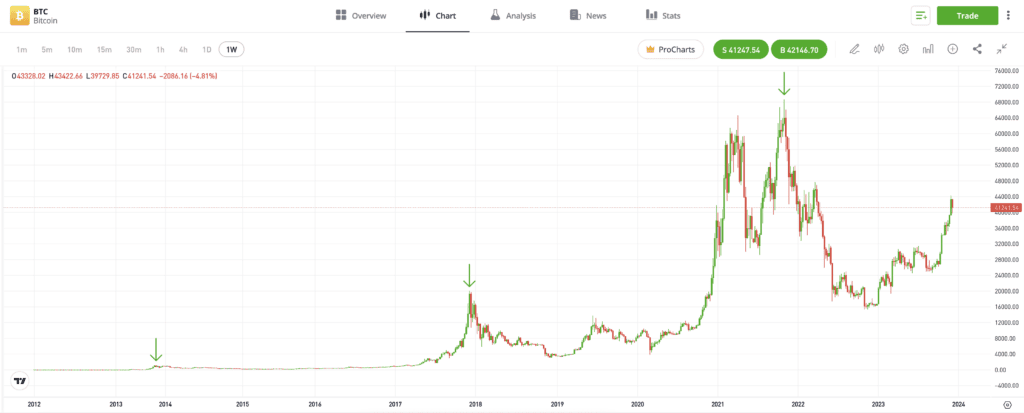Bitcoin has demonstrated patterns across previous four-year cycles, and many believe that the Bitcoin halving can potentially provide investors with some indication regarding price movements. Learn more about the Bitcoin halving cycle and its different stages, and how the halving might impact the bitcoin price.
The Bitcoin halving is an event that takes place approximately every four years. By cutting the supply of new bitcoin entering circulation, the halving has previously demonstrated significant influence over the price of bitcoin, acting as a catalyst for the formation of new, long-term price trends.
The next Bitcoin halving is expected to take place in April 2024, and so it is important to gain a better understanding of the four-year cycle that bitcoin has experienced since its creation.
Tip: The halving process restricts the introduction of new bitcoin to the circulating supply.

What is the Bitcoin four-year cycle?
Bitcoin miners are required to solve complex mathematical problems to validate transactions and create new blocks on the blockchain. Successful miners are rewarded with newly issued BTC for helping to secure the network.
However, this reward is cut in half once 210,000 new blocks have been created, hence the name given to the event. Historically, these Bitcoin halvings have occurred approximately every four years.
The Bitcoin halving has previously impacted the price of the cryptoasset, and so crypto investors usually monitor the four-year cycle closely to try and maximise their returns.
Tip: The date of each Bitcoin halving will be impacted by the speed at which new blocks are created.
Stages of the Bitcoin halving cycle
Previous Bitcoin halving cycles have led to significant price increases, and so investors typically pay attention to bitcoin and other cryptoassets in the run-up to the event.
The price of bitcoin follows several different stages. After previous halvings, the price of bitcoin demonstrated impressive growth in the following 12- to 18-month period, marked by a new all-time high set by the cryptoasset, as demonstrated in the BTC chart below. This period of time is typically referred to as a “crypto bull market.”
Following the setting of a new all-time high, bitcoin usually experiences a wider market selloff and considerable fall in price, which is often called a “crypto bear market.”

For illustration purposes only. Past performance is not an indication of future results.
Source: eToro
Experienced investors will attempt to buy bitcoin and other cryptoassets while the prices are lowest and then sell when they are highest, although there is no guarantee that the upcoming Bitcoin halving will follow the same pattern as previous four-year cycles.

Bitcoin halving dates history
The Bitcoin halving takes place approximately every four years, once the appropriate number of blocks have been created.
The dates of previous Bitcoin halving events are as follows:
- November 28th, 2012
- July 9th, 2016
- May 11th, 2020
These dates mark the exact point at which block rewards were reduced, although market conditions varied before and after these specific points in time.
Bitcoin price changes around halving cycles
Historical price data shows that the price of bitcoin increased between previous halving events. The similarities between past Bitcoin halvings often lead to upcoming halving events generating substantial interest from retail investors, as well as a growth in trading activity. This can result in additional price volatility, which is important to consider from a risk management perspective.
Tip: Bitcoin price moves can start in the build-up to the next halving event.
What causes bitcoin price changes around halving dates?
There are a range of factors that can influence the price of bitcoin. The basic premise, however, is that bitcoin – like any other asset – is impacted by the laws of supply and demand. Although this is always the case, market conditions are impacted by upcoming changes to the rewards system around the time of the halving. Restricting the supply of new coins into the market allows for scarcity, which influences demand.
Previous price increases associated with the halving event also encourage an influx of new investors, raising demand for the cryptoasset further still. Retail investors are more likely to start investing in bitcoin as media attention around the halving increases, which can help to drive the price higher.
Historical prices vs future bitcoin price predictions
Historical price movements can provide some indication as to any potential future BTC price movements, although wider macroeconomic factors will also play a role and should be taken into consideration.
Blockchain technology is still relatively new, and so although there are patterns highlighted by previous Bitcoin halvings, there is no way of knowing definitively how the bitcoin price will react to the next halving event.

Final thoughts
The Bitcoin halving is a relatively straightforward concept that has led to the formation of several patterns throughout a four-year cycle. Renewed interest from retail investors, reduced supply and historically volatile price movements typically cause trading volumes to increase around the time of the halving event, which can lead to a bitcoin price increase.
This positive price movement is then followed by a significant price decline, which usually leads into the next Bitcoin halving. Understanding how this cycle works can provide investors with a good basis for their investment decisions, although it is important to note that previous four-year cycles do not guarantee similar results in upcoming cycles.
Visit the eToro Academy to learn more about bitcoin and other cryptoassets.
FAQ
- Who owns the Bitcoin network?
-
The Bitcoin network is not owned by anyone. It was created by Satoshi Nakamoto, a pseudonymous individual or group, and the ongoing management of the blockchain is carried out by its users. Bitcoin’s Proof of Work (PoW) consensus mechanism enables the network to operate without needing to be overseen by a specific governing body.
- What is Proof of Work (PoW)?
-
Proof of Work is the technique used by some crypto networks, such as Bitcoin, to verify new transactions on a blockchain. Proof of Work is not the only mechanism available for validating transactions, but it is used by Bitcoin to remove third-party intermediaries from the process.
Proof of Work requires significant computational power, as Bitcoin “miners” compete to solve a complex mathematical problem. The successful miner adds a new block to the Bitcoin blockchain and is rewarded with the network’s native cryptoasset – in this case, bitcoin – as a result.
- What are the rewards for mining bitcoin?
-
When a Bitcoin miner validates a new block, they are rewarded with a set amount of bitcoin as a reward, although this reward halves periodically. Until April 2024, the reward for mining a new block on the Bitcoin network is 6.25 BTC. This will be decreased by 50% following the next halving event, meaning that miners will be rewarded with 3.125 BTC when they mine a new block.
This communication is for information and education purposes only and should not be taken as investment advice, a personal recommendation, or an offer of, or solicitation to buy or sell, any financial instruments.
This material has been prepared without taking into account any particular recipient’s investment objectives or financial situation and has not been prepared in accordance with the legal and regulatory requirements to promote independent research. Any references to past or future performance of a financial instrument, index or a packaged investment product are not, and should not be taken as, a reliable indicator of future results.
eToro makes no representation and assumes no liability as to the accuracy or completeness of the content of this publication.
Cryptoasset investing is highly volatile and unregulated in the UK and some EU countries. No consumer protection. Tax on profits may apply.


